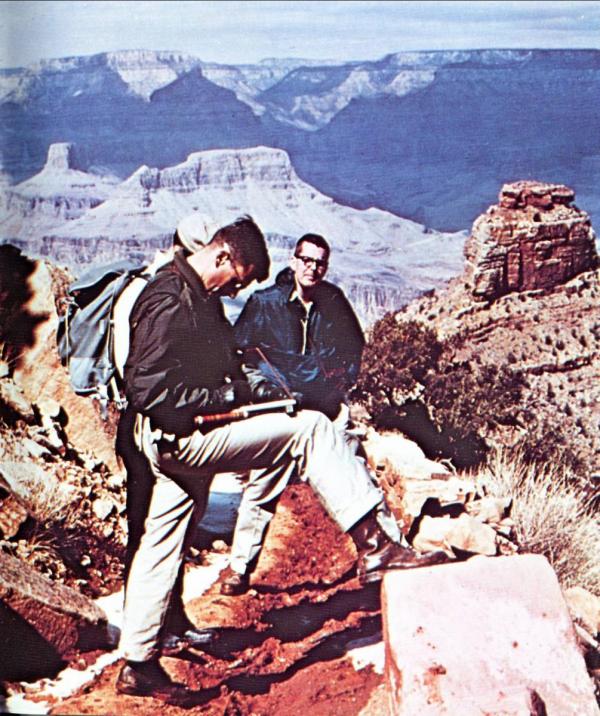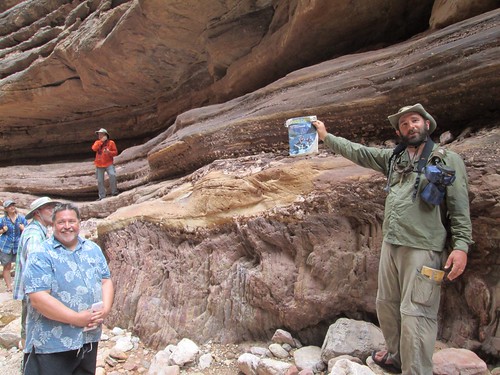 Astronaut Roger Chaffee and geologist Elbert King explore the Grand Canyon, March 5-6 1967. I believe the person standing directly beside and behind Chaffee is astronaut Michael Collins (based on the account and photographs in King’s memoir), with an unidentified person crouching behind. Collins undertook two spacewalks during the Gemini program and was the command module pilot for Apollo 11, orbiting the moon during Armstrong and Aldrin’s famous first steps on the Moon; Chaffee was killed in the Apollo 1 fire in 1967, along with Gus Grissom and Ed White. (Image by NASA.)
Astronaut Roger Chaffee and geologist Elbert King explore the Grand Canyon, March 5-6 1967. I believe the person standing directly beside and behind Chaffee is astronaut Michael Collins (based on the account and photographs in King’s memoir), with an unidentified person crouching behind. Collins undertook two spacewalks during the Gemini program and was the command module pilot for Apollo 11, orbiting the moon during Armstrong and Aldrin’s famous first steps on the Moon; Chaffee was killed in the Apollo 1 fire in 1967, along with Gus Grissom and Ed White. (Image by NASA.)You see the story yet? It’s all pretty much here. In a language you can’t yet understand, but it’s here. A tale of upheaval and battles won and lost. Gothic tales of sweeping change, peaceful times, and then great trauma again. And it all connects to our little [rock] friend.
That’s what we are, we geologists. Storytellers. Interpreters, actually.
—Prof. Lee Silver, played by David Clennon in From the Earth to the Moon
When NASA started planning trips to the Moon, they realized that once they got there, it would be important for astronauts to understand the rocks they were sampling. They needed to train their team of gutsy test pilots to do geology on the Moon, and it’s no accident that the training started with a hike in the Grand Canyon. The geology of the Canyon isn’t exactly like lunar geology, but it’s hard to imagine a better place to learn to read rocks. Every rock has a story, but the rocks in the Grand Canyon seem to be screaming theirs.
Whether you’re hiking down the Kaibab Trail (as the Apollo astronauts did in March 1964), or rafting down from Lee’s Ferry (as NCSE’s trip did this July), you start out in relatively young rocks. Those sediments were laid down in shallow seas about 270 million years ago. Then you descend through time, past rocks formed from fossilized dry sand dunes 275 million years old. You go deeper and deeper, through the remains of older seas, you see the hollows carved by ancient rivers into older sandstone, riverbeds which later filled with younger sediments that hardened to rock and were then overlaid by later seas. You learn the personalities of the rocks: the flamboyant Bright Angel shale, the proud Coconino sandstone, the laconic old Tapeats Sandstone, the cantankerous Vishnu schist.
In the eight days of NCSE’s recent Grand Canyon trip, we hit everything you need in Geology 101. We passed sedimentary, metamorphic, and igneous rocks. We saw how faulting distorted the rocks and opened up wide valleys, so different from the narrow river corridor. We were even lucky enough to witness some of the processes that carved the Grand Canyon. (Last year, while cruising through a torrential rainstorm, we saw a large flash flood burst out over a cliff, its slurry of sand and mud and boulders cutting its sidecanyon deeper into the rock. This year, we watched a small flash flood up close; scarier was the sudden rock cleavage that started a rockfall high up on the canyon wall.) Rafters who had never taken a geology class learned to identify the different layers, and start using what they saw in the rocks to ask questions about the ancient events which formed them. It doesn’t hurt that we had Steve Newton, an actual geologist, with us to explain the real story.
 The joking “two model” approach we take on the river helps, too. Since I’ve never taken a geology class, I know exactly enough to repeat (with a straight face) the creationist account of the formation of these rock layers during Noah’s Flood (all formed under water, of course, even the layers that could only have started as dry sand, and all hardened to rock in a matter of a year or so). Talking through the creationist claims helps the rafters look closely at the rocks and what they really show, how geology is really supposed to work, and thus how science works. They see how geologists build an evidence-based account of the Canyon’s and the rocks’ history, and how they could test geologists’ claims themselves. And they see how creationist accounts start from an answer and work backwards, torturing evidence to fit a predetermined conclusion. Pretty soon, we understand enough about how geologists see rocks that we can start to develop our own ideas about what we’re seeing, and explain some of the geology when Steve isn’t nearby.
The joking “two model” approach we take on the river helps, too. Since I’ve never taken a geology class, I know exactly enough to repeat (with a straight face) the creationist account of the formation of these rock layers during Noah’s Flood (all formed under water, of course, even the layers that could only have started as dry sand, and all hardened to rock in a matter of a year or so). Talking through the creationist claims helps the rafters look closely at the rocks and what they really show, how geology is really supposed to work, and thus how science works. They see how geologists build an evidence-based account of the Canyon’s and the rocks’ history, and how they could test geologists’ claims themselves. And they see how creationist accounts start from an answer and work backwards, torturing evidence to fit a predetermined conclusion. Pretty soon, we understand enough about how geologists see rocks that we can start to develop our own ideas about what we’re seeing, and explain some of the geology when Steve isn’t nearby.
Of course, as Steve likes to complain, there’s all sorts of green stuff getting in the way of the rocks, and noisy furry things crawling around on top of them, too. As a biologist, that’s the part that interests me. And while the transitions are subtler than the line between Redwall and Muav limestones, our trip was also a tour of the biomes of North America (as C. Merriam Hart pointed out over a century ago). Our 225 mile trip through the Grand Canyon actually started a hundred miles east, in Flagstaff, AZ, at the foot of the San Francisco Mountains. The day before our orientation, I hiked up Humphreys Peak, the highest mountain in Arizona, where there was still snow on the ground in July. Walking down, I went through alpine tundra with tiny plants like those you’d find above the treeline in the Rockies, through evergreen forests not so different from those of northern Canada, into deciduous forests reminiscent of eastern woodlands, and into broad grasslands like those I remember from Kansas. The drive to the Canyon took us through the drier and more typically western piñon pine/juniper grasslands, sagebrush grasslands, and then the edge of the cold Great Basin desert. By the end of the raft trip, we were surrounded by the plants and animals of the warm Mojave and Sonoran deserts.
The day before our orientation, I hiked up Humphreys Peak, the highest mountain in Arizona, where there was still snow on the ground in July. Walking down, I went through alpine tundra with tiny plants like those you’d find above the treeline in the Rockies, through evergreen forests not so different from those of northern Canada, into deciduous forests reminiscent of eastern woodlands, and into broad grasslands like those I remember from Kansas. The drive to the Canyon took us through the drier and more typically western piñon pine/juniper grasslands, sagebrush grasslands, and then the edge of the cold Great Basin desert. By the end of the raft trip, we were surrounded by the plants and animals of the warm Mojave and Sonoran deserts.
It’s easy for untrained eyes to miss the moment when you see the first barrel cactuses on Canyon’s walls, or the moment when violet-green swallows disappear from the air over the river, and I pointed those out as biological unconformities as meaningful as the Great Unconformity between the Tapeats and Vishnu Schist. But once rafters started noticing those changes, other patterns emerged. Lizards at some sites seemed darker than others (might sites with darker rocks also have darker lizards?). Tadpoles were common in some streams but absent elsewhere (are there chemical differences in the water, or could differences in rainflow mean later hatching in some places?). Some warm-desert plants appeared first on the warmer, sunnier north side of the river (barrel cactuses), while others first appeared on the south side (on the side of the river nearer their largest population density).
Recognizing those patterns let the rafters hear the stories that the rocks and living things had to tell. They could start doing science in that alien land, and interpret its language.
We hope that the rafters will find ways to continue asking those questions about the world around them, and especially that the teachers on the trip—including the two scholarship winners generously sponsored by people like you—will be able to bring those lessons back to their classrooms.

